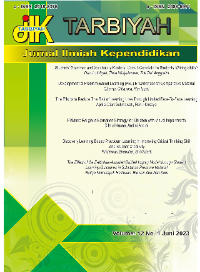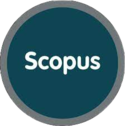Development of Four-Tier Instrument at First Intermediate Level Chemistry Concepts
DOI:
https://doi.org/10.18592/tarbiyah.v12i2.11399Keywords:
chemistry concepts, first intermediate level, four-tier instrument, misconceptionAbstract
Chemical concepts are tiered from simple to complex. If misconceptions occur in simple concepts, they can cause misconceptions in complex concepts. The four-tier instrument is a tool for detecting misconceptions. This research aims to develop and describe the validity and reliability of a four-tier instrument on junior secondary-level chemistry concepts. This development research consists of 6 procedures: (1) concept mapping, (2) testing, (3) defining unscientific concepts, (4) developing four-tier instrument prototypes, (5) validating four-tier instrument prototypes, and (6) finalization of four-tier instruments. The developed four-tier instrument consists of 27 questions that measure chemistry concepts at the junior intermediate level. The instrument received an expert validation score of 92.81% with very valid criteria. The test results on 30 samples showed a reliability value based on a Cronbach alpha score of 0.713 with good criteria. The four-tier instrument on lower secondary level chemistry concepts meets the validity and reliability requirements so that it can be used to diagnose misconceptions on lower secondary level chemistry concepts.References
Anggraeni, V., Enawaty, E., & Rasmawan, R. (2018). Deskripsi Miskonsepsi Siswa Pada Materi Atom, Molekul, Dan Ion Di SMP Negeri 21 Pontianak. Jurnal Pendidikan dan Pembelajaran Khatulistiwa, 7(1).
Anwarudin, A., Nuswowati, M., & Widiarti, N. (2019). Analisis Miskonsepsi Peserta Didik pada Materi Hidrolisis Garam Melalui Tes Diagnostik. Journal of Chemistry In Education, 8(1), 1-7.
Airasian, P.W. (1994). Classroom Assessment, Eds., Arker, L., & Rosenberg, E. Singapore: Mc Graw-Hill.
Astutik, T.P. (2017). Identifikasi Konsep Sukar dan Kesalahan Konsep Reaksi Redoks. Jurnal Zarah 5(1), 22-28. https://doi.org/10.31629/zarah.v5i1.155
Erduran, S., & Scerri, E. (2002). The Nature of Chemical Knowledge and Chemical Education. Dalam J.H.V. Driel, J.K.Gilbert, O.D.Jong, R. Justi, & D.F. Treagust (Eds), Chemical Education: Toward Research-based Practice. Netherlands: Kluwer Academic Publishers.
Fakhriyah, F., & Masfuah, S. (2021). The Development of a Four Tier-Based Diagnostic Test Assesment on Science Concept Course. Journal of Physics: Conference Series, 1842 (2021), 012069. https://doi.org/10.1088/1742-6596/1842/1/012069
Fantiani, C., Afgan, M.W., & Astuti, R.T. (2023). Analisis Miskonsepsi Siswa Berbantuan Certainty of Response Index (CRI) Pada Materi Pembelajaran Laju dan Orde Reaksi. Jurnal Inovasi Pendidikan Kimia, 17(1), 49-53. https://doi.org/1015294/jipk.v17i1.34946
Gurel, D.K., Eryilmaz A., & Mc Dermott, L.C. (2017). Development and Application of a Four-Tier Test to Assess Pre-Service Physics teachers’ Misconceptions About Geometrical Optics. Research in Science & Technological Education, 35(2), 238-260. https://doi.org/10.1080/02635143.2017.1310094
Gurel, D.K., Eryilmaz A., & Mc Dermott, L.C. (2015). A Review and Comparison of Diagnostic Instruments to Identify Students’ Misconceptions in Science. Eurasia Journal of Mathematics, Science and Technology Education, 11(5), 989-1008.
Habiddin, H., & Page, E. (2019). Development and Validation of a Four-Tier Diagnostics Instrument for Chemical Kinetics (FTDICK). Indonesian Journal of Chemistry, 19(3), 720. https://doi.org/10.22146/ijc.39218
Habidin., Ameliana, D.N., & Su’aidy, M. (2020). Development Of A Four-Tier Instrument Of Acid-Base Properties Of Salt Solution. Journal of Chemistry Education Research, 4(1), 51-57.
Irawati, R. K., & Sofianto, E. W. N. (2019). The Misconception Analysis of Natural Science Students on Heat and Temperature Material using Four Tier Test. Journal of Physics: Conference Series, 1321(3), 032104. https://doi.org/10.1088/17426596/1321/3/032104
Jusniar, J., Effendy, E., Budiasih, E., & Sutrisno, S. (2020). Misconception in Rate of Reaction and Their Impact on Misconceptions in Chemical Equilibrium. European Journal of Educational Research, 9(4), 1405-1423.
Karim, F., Ischak, N.I., Mohamad, E., Aman, L.O., & Salimi, Y.K. (2022). Identifikasi Miskonsepsi Ikatan Kimia Menggunakan Diagnostic Test Multiple Choice Berbantuan Certainty of Response Index. Jambura Journal of Educational Chemistry, 4(1), 19-25. https://doi.org/10.34312/jjec.v4i1.13239
Kimberlin, C.L., & Winterstein, A.G. (2008). Validity and Reliability of Measurement Instruments Used In Research. Am J Health Syst Pharm, 65(23), 2276-2284.
Mursiti, S., Fardhyanti, D.S., Cahyono, E., & Sudarmin. (2006). Remediasi Miskonsepsi Orbital Atom, Orbital Molekul, dan Hibridisasi Melalui Pembelajaran Interaktif dengan Animasi Simulasi Berbantuan Komputer. Jurnal Indo. J. Chem., 6(1), 104-110.
Putri, R, E., & Subekti, H. (2021). Analisis Miskonsepsi Menggunakan Metode Four-Tier Certainty of Response Index: Studi Eksplorasi Di SMP Negeri 60 Surabaya. Pensa E-Jurnal: Pendidikan Sains, 9(2), 220-226.
Riduwan & Akdon. (2013). Rumus dan Data dalam Analisis Statistika. Bandung: Alfabeta.
Rohmah, R.S., Nikmatin, S., Pratiwi, Y.N., & Analita, R.N. (2022). Analysis of Students’Chemical Bonding Misconception with A Four-Tier Diagnostic Test. JTK: Jurnal Tadris Kimiya, 7(2), 166-174. https://doi.org/10.15575/jtk.v7i2.20343
Rohmanasari, F., & Ermawati, F.U. (2019). Validitas dan Reliabilitas Instrumen Tes Diagnostik Miskonsepsi Berformat Four-Tier Pada Materi Alat Optik. Inovasi Pendidikan Fisika, 8(2), 556-559.
Savira, I., Wardani, S., & Harjito. (2019). Desain Instrumen Tes Three-Tiers Multiple Choice untuk Analisis Miskonsepsi Siswa Terkait Larutan Penyangga. Jurnal Inovasi Pendidikan Kimia, 13(1), 2277-2286.
Sugiyono. (2015). Metode Penelitian Pendidikan Pendekatan Kuantitatif, Kualitatif, dan R&D. Bandung: Alfabeta.
Syahrul, D.A. (2015). Identifikasi Miskonsepsi dan Penyebab Miskonsepsi Siswa dengan Three-tier Diagnostic Test Pada Materi Dinamika Rotasi. Jurnal Inovasi Pendidikan Fisika, Universitas Negeri Surabaya, 4(3), 67-70.
Taber, K.S. (2001). Building the Structural Concepts of Chemistry: Some Considerations from Educational Research. Chemistry Education: Research anda Practice in Europe, 2(2), 123-158.
Treagust, D., & Tsui, C-Y. (2010). Evaluating Secondary Students’ Scientific Reasoning in Genetics Using a Two-Tier Diagnostic Instrument. International Journal of Science Education. 32(8), 1073-1098.
Yolviansyah, F., Maison, & Kurniawan, D.A. (2022). Identifikasi Miskonsepsi Peserta Didik pada Pembelajaran Fisika di SMAN 8 Kota Jambi. Jurnal Edumaspul, 6(1), 541-545. https://doi.org/10.33487/edumaspul.v6i1.3164
Downloads
Published
How to Cite
Issue
Section
License
Copyright (c) 2024 Andri Wahyu Wijayadi, Lina Arifah Fitriyah, Oktaffi Arinna Manasikana

This work is licensed under a Creative Commons Attribution 4.0 International License.
Authors retain copyright and grant the journal right of first publication with the work simultaneously licensed under a Creative Commons Attribution 4.0 International License that allows others to share the work with an acknowledgment of the work's authorship and initial publication in this journal.




